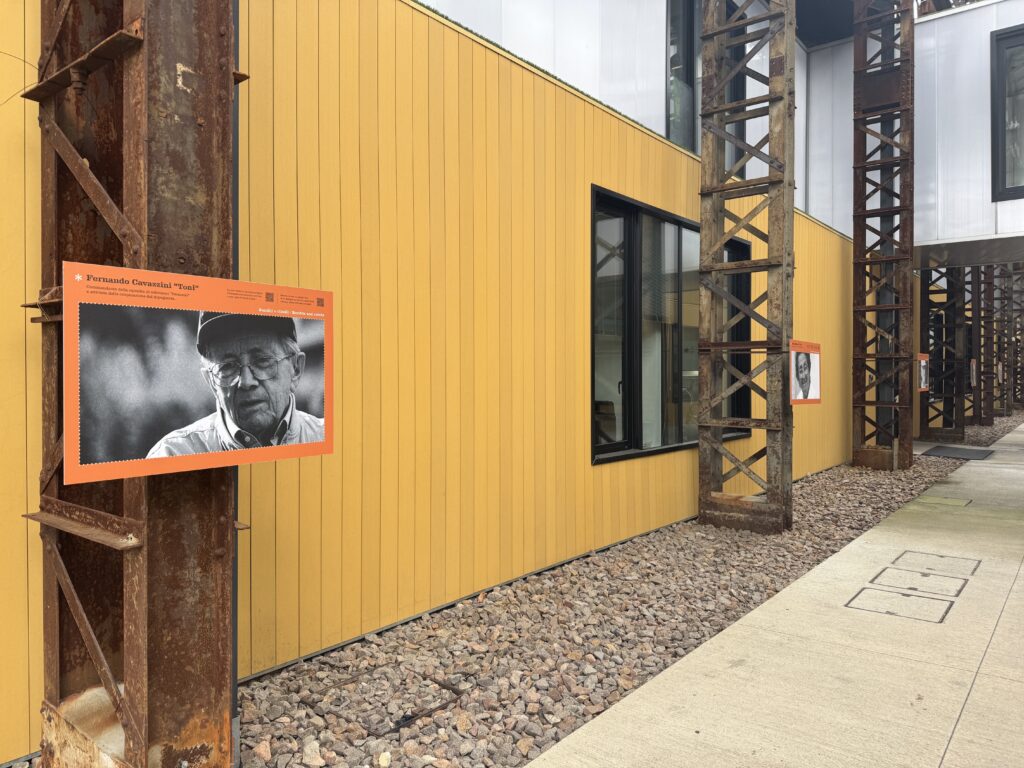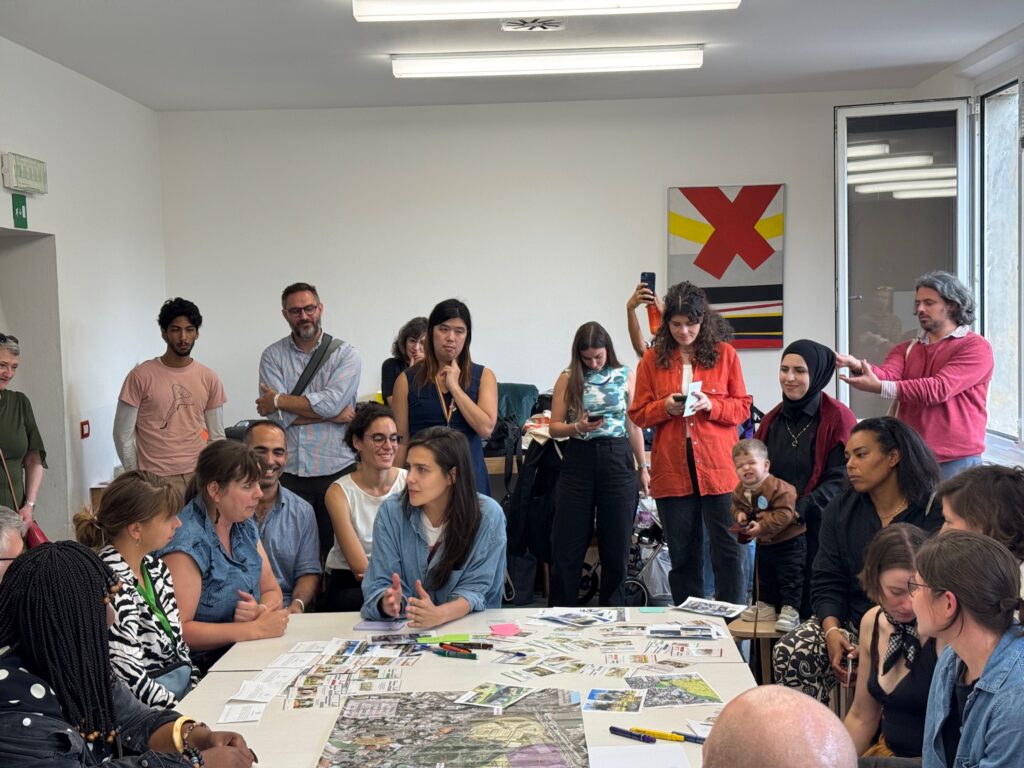European Placemaking Week 2025 brought together hundreds of placemaking* practitioners from across the world in Reggio Emilia. Taking part from Hundipea were community manager Maarja Matteus and architect–urban planner Darina Nossova. According to Maarja, the week was a recognition in the best sense – the questions and challenges of public space are remarkably similar in Italy, Estonia and elsewhere in the world.
Placemaking Week is Europe’s largest festival dedicated to placemaking, held each year in a different country. It brings together urban planners, architects, activists, community organisers, and policy-makers to inspire one another, exchange knowledge, and strengthen collaboration. In 2025, the event took place in Reggio Emilia, an Italian city with a strong industrial heritage.
One of the central themes of the week was care in placemaking – care and a sense of safety in public space. Maarja says this also means having the courage to recognise how differently people experience urban environments. “What seems like an ordinary street or tunnel to one person may feel unsafe or unwelcoming to another. If spaces are designed only by people with similar backgrounds, they can never truly work for everyone,” she notes.
Discussions also explored how to bring joy and spontaneity back into the city – through street music, dance, and culture. “Dance and movement are part of a living city. It’s the energy that gives it life,” says Maarja. The idea resonated as a reminder that caring for a city means not only making it safe but also light and playful.

Water as part of public space
For Darina, one of the most striking topics was the relationship between water and the city. In Reggio Emilia, participants discussed how rivers and canals – long forgotten or covered by asphalt – could once again become public spaces. “It made me think about Hundipea, where the sea has enormous potential as a public space. But for people to feel safe there, the waterfront needs to be accessible. There should be places to sit, swim, or simply be by the water,” she says.
Darina recalls her childhood in Sillamäe, East Estonia, where the river and reservoir were surrounded by fear. “We were always warned not to go near the river – it was dangerous! From an early age, you understood that water was something to avoid.”
That’s why she believes it’s important to rethink our relationship with water: “When we make the shores accessible, clean them and study the water’s condition, the waterfront once again becomes a natural and safe part of the city.”
A fresh look at heritage
This year, many discussions in Reggio Emilia focused on heritage reimagined – how layers of historical urban space should not only be preserved, but brought back to life. Reggio Emilia’s old town shares a familiar challenge with Tallinn’s: both have lost some of their everyday vibrancy. Many businesses have moved out, and locals rarely spend time there.
Speakers emphasised the need to find new functions for old buildings and to move away from the idea that heritage is something to be merely maintained. Heritage should also be able to create new value. At the same time, it was noted that such development is often hindered by a lack of funding – maintaining and renewing historical buildings and spaces can be far more costly than new construction.
One memorable line from the festival captured this tension: “Without an adequate budget, placemaking is just placewashing.” Maarja admits that while the statement was sharply put, it contains more than a grain of truth.
She says the discussion on urban heritage also offered an important takeaway for us at Hundipea: “When it comes to former industrial areas, the question is always how much new to add and how much of the old to keep. What we saw confirmed that a strong place identity is born when the old and the new intertwine.”
“I liked how at the festival venue – Reggiano Parco Innovazione – the city’s industrial past had been brought back into people’s everyday lives,” she adds. “On the walls of the former factory buildings were enlarged photos and stories of past workers. Some old machines had also been integrated into the new spaces instead of being removed. It gave the sense that the new environment respects the old – and keeps more soul in it.”
We’ve tried a similar approach at Hundipea – the wall of a former industrial admin-building now serves as a gallery space, and several art installations can be found in the courtyard as part of the ‘Lähme nulli!’ exhibition.

Inspiring lectures and workshops
Darina says she was particularly impressed by a workshop based on the methods of renowned Danish urbanist Jan Gehl. The strength of his approach lies in its simplicity: observe people and their behaviour in space. “Differentiate between movement and lingering – who is walking, who is sitting, how many are women, men, children. It sounds basic, but it actually provides incredibly valuable information,” she explains.
What was innovative, she adds, is that Gehl’s office has developed a special app for this method, which participants could try on site. “It’s a bit funny, because the method itself is so simple – yet the app makes the process more efficient and data collection more accurate,” says Darina.
She was most inspired by practical, everyday examples where local residents themselves had initiated changes to improve spatial quality. “One of the key lessons was that initiatives don’t have to come from officials or experts. I saw examples of people who decided to reimagine their own street, sketched a vision and involved their neighbours. Once an idea takes root in the community, it can become reality.”
She also mentioned an example from France, where abandoned buildings are temporarily used to provide social services – whether short-term accommodation or community centres. “It was interesting to consider how many privately owned buildings in Tallinn could host similar temporary uses in collaboration with the city.”

What makes a good public space?
Darina says this question is always a bit of a tricky one. “I once asked my professor what makes a good public space. He looked at me and said: ‘I won’t tell you. You have to decide.’ It’s every architect’s and designer’s responsibility to define what makes space good,” she recalls.
She adds that everyone can learn simply by observing: “Look at how others have done it and ask yourself whether it works – do you agree with the solution?”
Maarja believes that a good public space is, above all, non-commercial – a place where you can simply be, without having to buy anything. “There should be something for people of different ages and backgrounds. Not everyone has to do the same thing, but everyone should have their own space. A sense of safety is also part of it.”
She emphasises that public space should be understood broadly. “It’s not only parks or squares. A schoolyard, for example, can be a community place – an open area where people come after school to play or walk.” As an example, she mentions the schoolyard of Lilleküla School in Tallinn, which residents themselves hope to redesign through participatory budgeting into a shared community space. “Such ideas could spread more widely,” she adds. “And the blue network of the city – the water systems Darina mentioned – is also part of public space and should be accessible to everyone.”
She also found the discussion at the festival about cemeteries as public spaces intriguing: “In different cultures, they carry different meanings. The question is how to interpret and open them up. People visit them, they’re part of the community – it was interesting to consider how even this part of urban space could be rethought.”
Takeaways from Reggio Emilia
Placemaking is a process, not a one-off project.
Urban space needs ongoing care and attention even after construction is finished.
Temporary use can create lasting value.
Pilot areas and temporary spatial solutions keep neighbourhoods alive, build connections with future residents and offer opportunities for learning.
Heritage can be a starting point for the future.
Historical layers give a city its identity. It’s not just about preserving buildings but also about creating meaning for new generations.
Get involved
If you have ideas or wishes for the public spaces at Hundipea, get in touch with Maarja.
*Placemaking refers to a process in which community members, urban planners and designers work together to create or improve public spaces so that they are human-centred, functional and meaningful.


